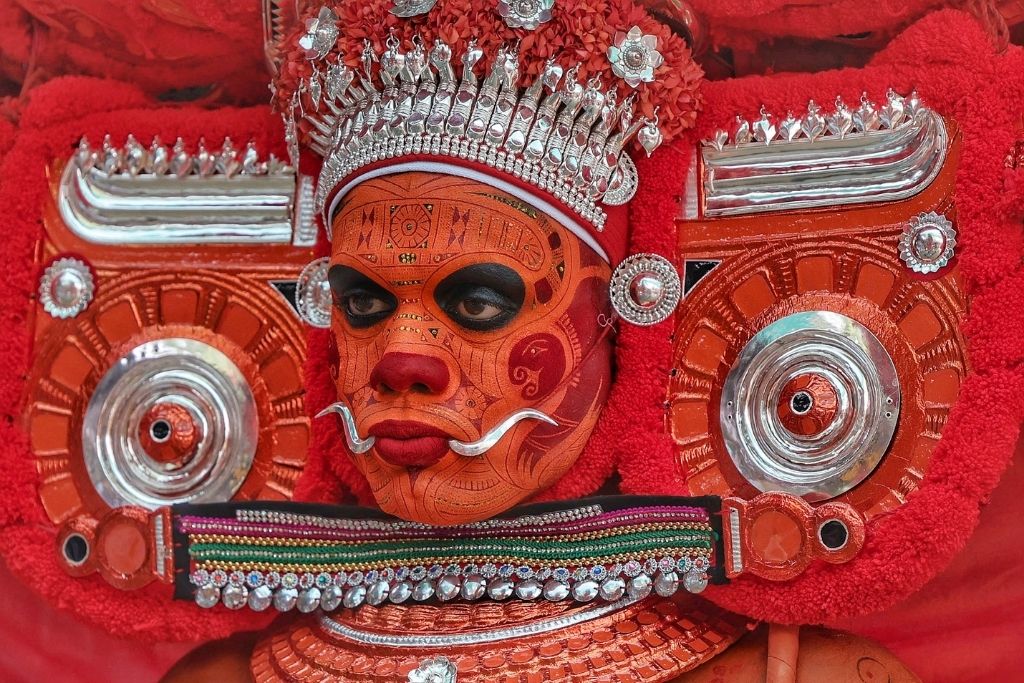
Theyyam – Narrating stories of gods
Theyyam, also known as kaliyattam, derives its origin from the Malayalam word "daivam", which means god. The performance, held mostly in the rural districts of Kannur and Kasargod of Kerala between December and April, is often confused with the more popular Kathakali, thanks to its elaborate costume, headgear and makeup. However, there are more than 450 forms of theyyam, each with a distinct costume, makeup and ritual. Like many other traditional performing art forms of the country, theyyam too uses the elements of dance, music and theatre to narrate the stories of deities or legendary heroes.
Though theyyam involves dance, makeup and mime, with the artiste performing in elaborate makeup and costume, it is not merely a dance but a ritual considered sacred by the believers. The local residents believe that their god descends in a human body to interact with and bless them.
Bali theyyam is based on the character of Bali from Ramayana, a heroic warrior who is tragically killed. Here he is seen in action with excited kids in the backdrop.
For the spectators, this is no ordinary performance. The dancers are thought to get possessed by holy spirits. The ambience is thick with the feelings of divinity and spirituality, and many spectators narrate the feeling of getting lost in the moment. The performance involves several steps, including an elaborate preparation. Seen here is Gulikan vellatam — a step before the actual theyyam recital.
Velattam is the series of rituals preceding the theyyam recital, wherein the legends about the deity are sung and the performer is in minimal gear and makeup. Velattam can be held over the entire day, before the artiste, wearing full makeup and adornments, appears as the god. When appearing in full getup, he is also called theyyam.
The performer starts his preparation a couple of weeks before the D-day, during which he spends his time in prayers, and observes fasting and abstinence. Theyyam performers generally hail from the same family lineage.
Kandanar Kelan theyyam is perhaps the most intense, fast paced and fiery theyyam of all. It tells the legend of an adventurous boy named Kelan who is engulfed in a forest fire and is later resurrected from the ashes by another warrior god called Wayanattu.
The recital includes spellbinding scenes such as the one that shows Kelan’s anger towards the blaze. He runs and ravages through the pyre and stomps it out quickly, mesmerising the audience with the spectacular action.
The ritual ends with the dancers showering blessings in the form of turmeric powder and rice. When the music begins to wind down, the devotees throw this rice on the theyyam.
Theyyam performers traditionally belong to the lower caste. This is seen as a democratisation of religion, wherein the gods are believed to leave the confines of the temple, enter the theyyam’s body, and meet everyone, irrespective of caste or creed.
Karingali theyyam being performed at Mathikavu Bhagavathi temple in Kannur district, wherein the performer is seen as a full theyyam.
After the conclusion of their performance, the dancers meet the spectators. The crowd gathers around them, seeking blessings and advice on how to overcome adversity. The photo shows Gulikan theyyam, which is characterised by an elaborate face mask with the trident of Lord Shiva prominent on the forehead.
Music is an integral part of the theyyam performance, featuring instruments like drums such as chenda and veekkuchenda, elathalam (cymbals), and kurumkuzal (a wind instrument).
The lead image shows an artiste performing as Puliyoor Kali Theyyam, with an intricate face painting showing a lion cub on his cheek.
Dr. A V Ranganadham is an orthopaedic surgeon who loves to travel and bring back images.











